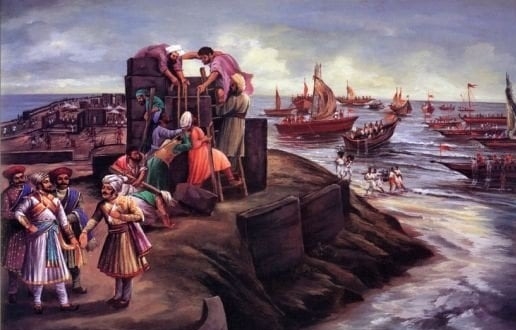Major shift from colonial practice! Navy Day to be celebrated at Ch. Shivaji Maharaj's Sindhudurg fort
14 Sep 2023 12:53:38
In a major shift from colonial practice, Navy Day will be celebrated in a grand manner on December 4 at the historic and impregnable Sindhudurga, recognized as the main centre of the Maratha armour. The Sindhudurg Fort was built in the 1660s.


As per the report, this will be the tribute to Ch. Shivaji Maharaj and his foresight in building a formidable naval force.This historic celebration outside the national capital marks a new tradition, highlighting our commitment to indigenous customs and values.
Also Read |
Connecting the new naval ensign with Father of Indian Navy - Chhatrapati Shivaji Maharaj
India celebrates Navy Day on December 4 to commemorate the Indian Navy’s attack on the Karachi harbour during the 1971 war against Pakistan. It should be remembered that last year, Navy Day was celebrated in Visakhapatnam, the first time it was taken outside New Delhi. The Indian Army and the Indian Air Force organised their annual parades in Bengaluru and Chandigarh last year. This year’s Air Force Day parade will be held at Prayagraj in Uttar Pradesh on October 8.
“Navy Day was celebrated on the east coast last year. This year, the celebrations will be organised on the west coast. The venue has been chosen carefully and the Sindhudurg Fort meets the navy’s requirements to conduct an operational demonstration of its frontline assets. It also has rich maritime history,” said one of the officials cited above, asking not to be named.
On the occasion of Navy Day, the strength of the Indian Navy will be displayed in the sea of Sindhudurga. 70 warships will participate in this program to be held in Sindhudurga.
Last year, Prime Minister Narendra Modi unveiled the navy’s new ensign at the commissioning ceremony of aircraft carrier INS Vikrant, with the flag drawing inspiration from the seal of the Maratha king, dropping the Cross of St George. The PM called it ‘getting rid of the burden of a colonial past’.
About Sindhudurg Fort
The fort was built in the 17th century by the Maratha king, Chhatrapati Shivaji Maharaj, to defend the region against invading foreign powers. It is a remarkable example of the Maratha military architecture of the 17th century. The fort’s construction technique, called the “Tekdi technique,” is unique and impressive.
The fort has a rich history of battles fought against the British and Portuguese forces. In 1713, the fort was besieged by the British under the command of Colonel Robert Cowan, but it withstood the attack and the British forces retreated. The fort was also attacked by the Portuguese forces in 1737, but they were repelled by the Maratha forces.
About Shivaji Maharaj's Navy
Shivaji Maharaj's navy played a crucial role in battles like the Battle of Surat and successfully defended the Maratha coastline against foreign invasions, thereby solidifying his legacy as a naval strategist.
Shivaji Maharaj’s naval strategies have been called “The most important Indian strategies in Medieval India”. His concept of “Seapower” was based on the idea that the most powerful navy would control the Indian Subcontinent. His naval strategies greatly influenced navies worldwide, including the European powers like the Dutch, Portuguese, and English Navy, during Medieval India.
Panvel, Colaba, Kharepatan, Malvan, Kalyan, Vengurla and other places had ship-building yards for the repair and construction of all kinds of warships. Shivaji’s fleet consisted of around 500 warships divided into two squadrons, with each squadron led by high-ranking Admirals.
The Maratha Navy had different types of fighting ships: Gurabs, Galbats or Gallivats, Pals and Manjhuas. A Large number of ships must have been kept to guard more than 20 ports and sea forts such as Padmadurg, Vijaydurg, Suvarnadurg, Sindhudurg & others. He conquered many regions with his strong Navy such as Barsur, Konkan, Kanheri, Phonda (Goa) & so many others. Maharaj freed the Barsur coast in Karnataka from Portuguese rule.
